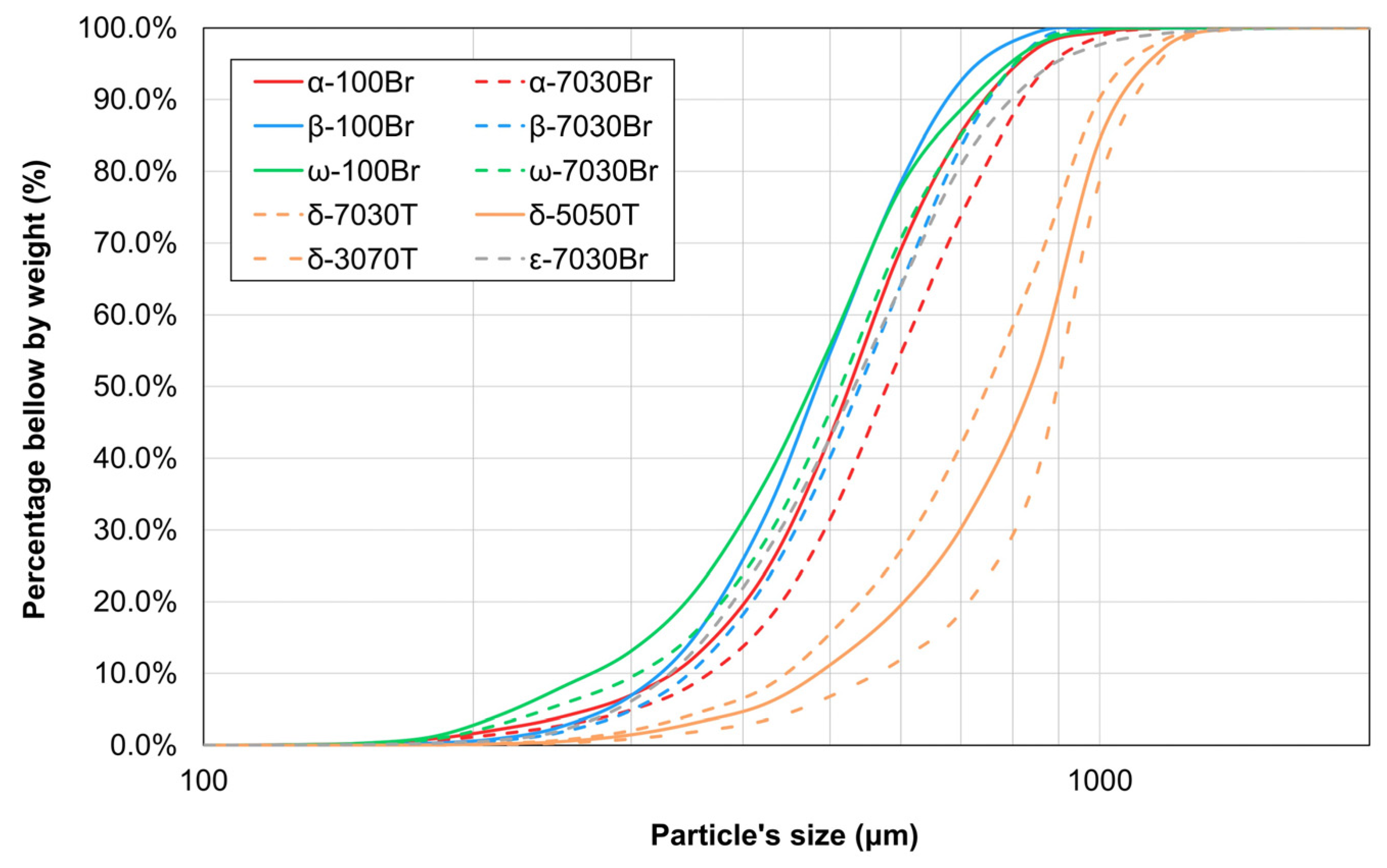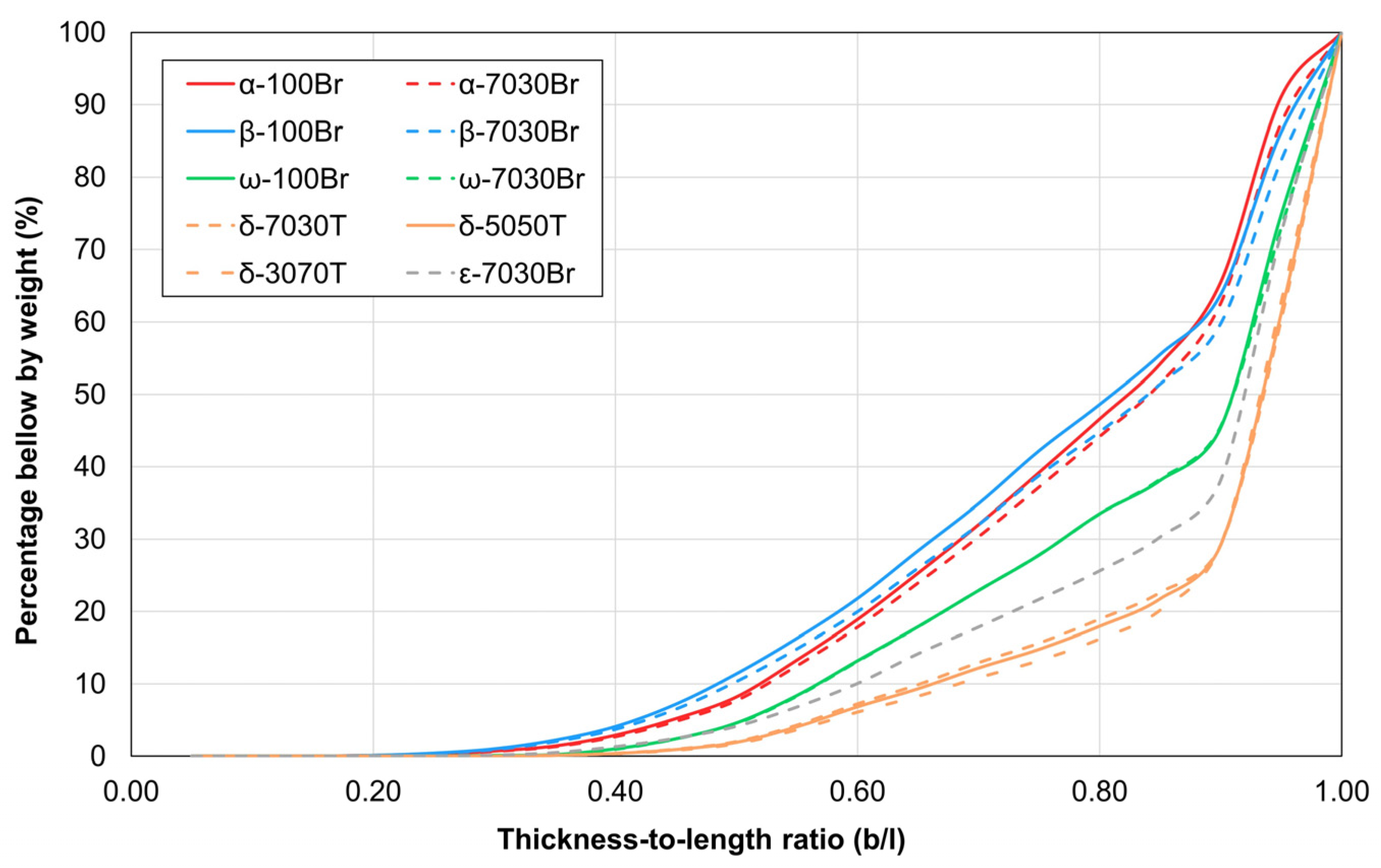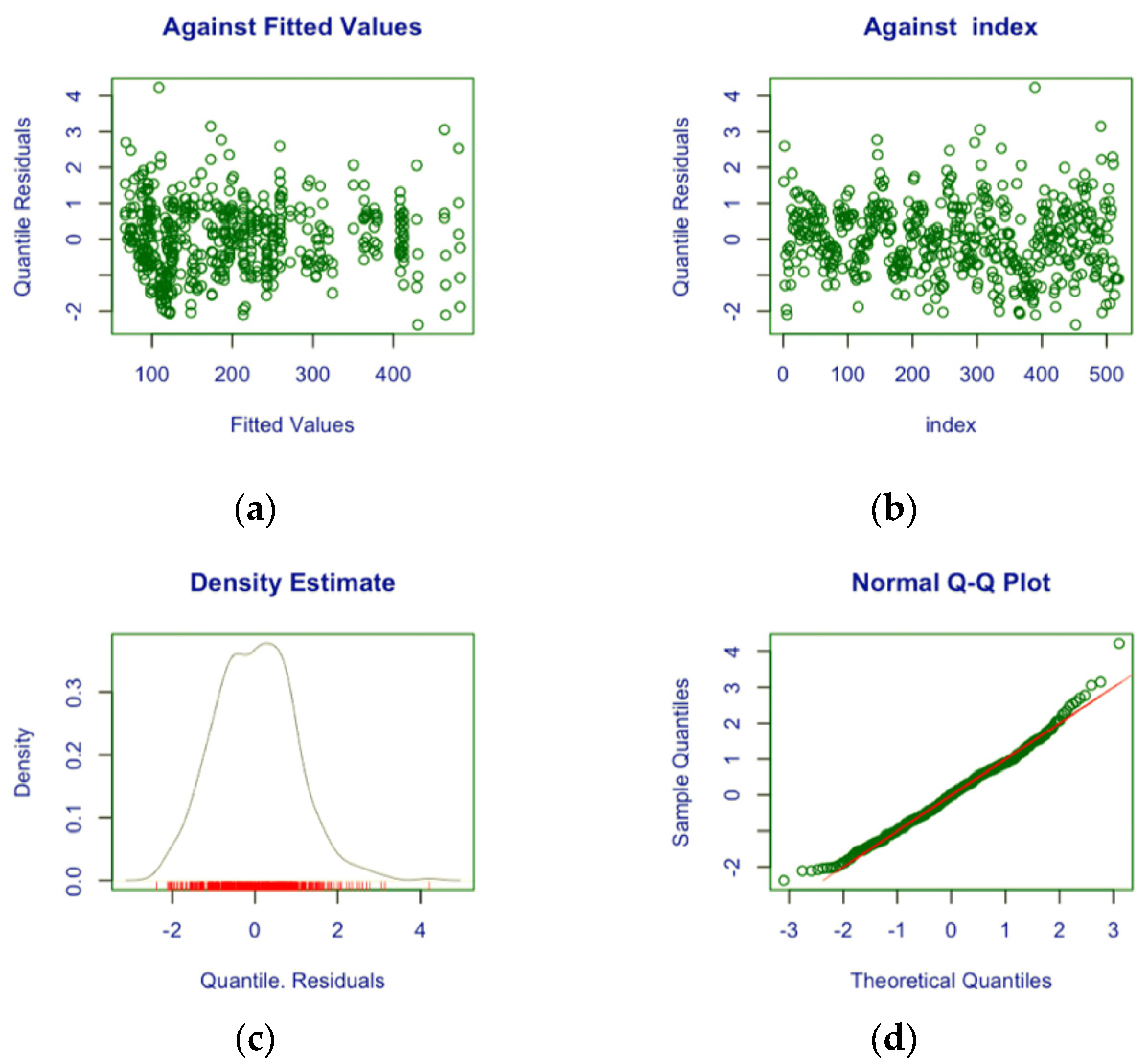Field Data Analysis of Pavement Marking Retroreflectivity and Its Relationship with Paint and Glass Bead Characteristics
Abstract
:Featured Application
Abstract
1. Introduction
1.1. Road Safety and Pavement Markings’ Retroreflectivity
1.2. Performance of Pavement Markings’ Retroreflectivity
1.3. Degradation Models
1.4. Objective
2. Materials and Methods
2.1. Materials
2.2. Methods
2.3. Experimental Design
3. Material Characterization Results
3.1. Paint Characterization
3.2. Glass Bead Characterization
4. Test Site Results: Statistical Analysis
4.1. Model Adjustment
4.2. Results Analysis
5. Discussion
5.1. Glass Bead Characteristics
5.2. Paint Characteristics
6. Conclusions
Author Contributions
Funding
Institutional Review Board Statement
Informed Consent Statement
Data Availability Statement
Conflicts of Interest
References
- WHO-World Health Organization. Global Plan for the Decade of Action for Road Safety 2021–2030; World Health Organization: Geneva, Switzerland, 2021. [Google Scholar]
- Burghardt, T.E.; Mosböck, H.; Pashkevich, A.; Fiolić, M. Horizontal Road Markings for Human and Machine Vision. In Proceedings of the Transportation Research Procedia; Elsevier: Amsterdam, The Netherlands, 2020; Volume 48. [Google Scholar]
- Smadi, O.; Souleyrette, R.R.; Ormand, D.J.; Hawkins, N. Pavement Marking Retroreflectivity Analysis of Safety Effectiveness. Transp. Res. Rec. 2008, 2056, 17–24. [Google Scholar] [CrossRef]
- E1710-11; Standard Test Method for Measurement of Retroreflective Pavement Marking Materials with CEN-Prescribed Geometry Using a Portable. American Society for Testing and Materials: West Conshohocken, PA, USA, 2011.
- Carlson, P.J.; Park, E.S.; Kang, D.H. Investigation of Longitudinal Pavement Marking Retroreflectivity and Safety. Transp. Res. Rec. 2013, 2337, 59–66. [Google Scholar] [CrossRef]
- Guan, Y.; Hu, J.; Wang, R. Study on the Enrichment of Pavement Marking Width and Retroreflectivity on Elderly Drivers’ Safety. Transp. Res. Rec. 2024. [Google Scholar] [CrossRef]
- Babić, D.; Fiolić, M.; Babić, D.; Gates, T. Road Markings and Their Impact on Driver Behaviour and Road Safety: A Systematic Review of Current Findings. J. Adv. Transp. 2020, 2020, 1–19. [Google Scholar] [CrossRef]
- Smadi, O.; Hawkins, N.; Aldemir-Bektas, B.; Carlson, P.; Pike, A.; Davies, C. Recommended Laboratory Test for Predicting the Initial Retroreflectivity of Pavement Markings from Glass Bead Quality. Transp. Res. Rec. J. Transp. Res. Board 2014, 2440, 94–102. [Google Scholar] [CrossRef]
- Wenzel, K.M.; Burghardt, T.E.; Pashkevich, A.; Buckermann, W.A. Glass Beads for Road Markings: Surface Damage and Retroreflection Decay Study. Appl. Sci. 2022, 12, 2258. [Google Scholar] [CrossRef]
- Zhang, G.; Hummer, J.E.; Rasdorf, W. Impact of Bead Density on Paint Pavement Marking Retroreflectivity. J. Transp. Eng. 2010, 136, 773–781. [Google Scholar] [CrossRef]
- Babić, D.; Burghardt, T.E.; Babić, D. Application and Characteristics of Waterborne Road Marking Paint. Int. J. Traffic Transp. Eng. 2015, 5, 150–169. [Google Scholar] [CrossRef]
- Andrady, A.L. Pavement Marking Materials: Assessing Environment Friendly Performance; National Academy Press: Washington, DC, USA, 1997; ISBN 0309060648. [Google Scholar]
- Lee, J.T.; Maleck, T.L.; Taylor, W.C. Pavement Marking Material Evaluation Study in Michigan. ITE J. Institute Transp. Eng. 1999, 69, 44. [Google Scholar]
- Abboud, N.; Bowman, B.L. Cost- and Longevity-Based Scheduling of Paint and Thermoplastic Striping. Transp. Res. Rec. 2002, 1974, 55–62. [Google Scholar] [CrossRef]
- Zhang, Y.; Wu, D. Methodologies to Predict Service Lives of Pavement Marking Materials. J. Transp. Res. Forum 2010, 45, 5–18. [Google Scholar] [CrossRef]
- Hummer, J.E.; Rasdorf, W.; Zhang, G. Linear Mixed-Effects Models for Paint Pavement-Marking Retroreflectivity Data. J. Transp. Eng. 2011, 137, 705–716. [Google Scholar] [CrossRef]
- Robertson, J.; Sarasua, W.; Johnson, J.; Davis, W. A Methodology for Estimating and Comparing the Lifecycles of High-Build and Conventional Waterborne Pavement Markings on Primary and Secondary Roads in South Carolina. Public Work. Manag. Policy 2013, 18, 360–378. [Google Scholar] [CrossRef]
- Sitzabee, W.E.; White, E.D.; Dowling, A.W. Degradation Modeling of Polyurea Pavement Markings. Public Work. Manag. Policy 2013, 18, 185–199. [Google Scholar] [CrossRef]
- Babić, D.; Ščukanec, A.; Babić, D.; Fiolić, M. Model for Predicting Road Markings Service Life. Balt. J. Road Bridg. Eng. 2019, 14, 341–359. [Google Scholar] [CrossRef]
- Mousa, M.R.; Mousa, S.R.; Hassan, M.; Carlson, P.; Elnaml, I.A. Predicting the Retroreflectivity Degradation of Waterborne Paint Pavement Markings Using Advanced Machine Learning Techniques. Transp. Res. Rec. 2021, 2675, 483–494. [Google Scholar] [CrossRef]
- NBR 16184:2021; Sinalização Horizontal Viária—Esferas e Microesferas de Vidro—Requisitos e Métodos de Ensaio. Associação Brasileira de Normas Técnicas:: Rio de Janeiro, RJ, Brazil, 2021.
- AASHTO M247-13; Standard Specification for Glass Beads Used in Pavement Markings. American Association of State Highway and Transportation Officials: Washington, DC, USA, 2013.
- D562-14; Standard Test Method for Consistency of Paints Measuring Krebs Unit (KU) Viscosity Using a Stormer-Type Viscometer. American Society for Testing and Materials: West Conshohocken, PA, USA, 2014.
- D1475-13; Standard Test Method for Density of Liquid Coatings, Inks, and Related Products. American Society for Testing and Materials: West Conshohocken, PA, USA, 2013.
- D2792-17; Standard Practice for Solvent and Fuel Resistance of Traffic Paint. American Society for Testing and Materials: West Conshohocken, PA, USA, 2017.
- AASHTO R98-20; Standard Practice for Standard Practice for Determination of Size and Shape of Glass Beads Used in Traffic Markings by Means of Computerized Optical Method. American Association of State Highway and Transportation Officials: Washington, DC, USA, 2020.
- Google Earth 10.49.0.0 Test Site View (22°54’31’’ S 46°25’29’’ W). Available online: https://www.google.com/earth/about/ (accessed on 12 March 2024).
- NTPEP. NTPEP Best Practices Manual; American Association of State Highway and Transportation Officials: Washington, DC, USA, 2004. [Google Scholar]
- Zhang, Y.L.; Pike, A.M.; Ge, H.C.; Carlson, P.J. Comparison of Designs of Field Test Decks for Pavement Marking Materials. Transp. Res. Rec. 2011, 5, 95–102. [Google Scholar] [CrossRef]
- Pike, A.M.; Songchitruksa, P. Predicting Pavement Marking Service Life with Transverse Test Deck Data. Transp. Res. Rec. J. Transp. Res. Board 2015, 2482, 16–22. [Google Scholar] [CrossRef]
- Mazzoni, L.N.; Ho, L.L.; Vasconcelos, K.L.; Bernucci, L.L.B. Probabilistic Service Life Model of Pavement Marking by Degradation Data. Transp. Res. Rec. 2022, 2676, 328–340. [Google Scholar] [CrossRef]
- NBR 13699:2021; Sinalização Horizontal Viária-Tinta à Base de Resina Acrílica Emulsionada Em Água. Associação Brasileira de Normas Técnicas: Rio de Janeiro, RJ, Brazil, 2021.
- Migletz, J.; Fish, J.K.; Graham, J.L. Roadway Delineation Practices Handbook; Federal Highway Administration: Washington, DC, USA, 1994. [Google Scholar]
- Chai, X.; Sheng, Y.; Liu, J.; Xu, Y.; Liu, H. Experimental Study on the Mechanical Properties of Saturated Tailing Sand with Different Particle Sizes. Appl. Sci. 2022, 12, 12231. [Google Scholar] [CrossRef]
- Daghistani, F.; Abuel-Naga, H. Evaluating the Influence of Sand Particle Morphology on Shear Strength: A Comparison of Experimental and Machine Learning Approaches. Appl. Sci. 2023, 13, 8160. [Google Scholar] [CrossRef]
- Pinto, C. De S. Curso Básico de Mecânica Dos Solos, 3rd ed.; Oficina dos Textos: São Paulo, SP, Brazil, 2006. [Google Scholar]
- Stasinopoulos, M.D.; Rigby, R.A.; Heller, G.Z.; Voudouris, V.; De Bastiani, F. Flexible Regression and Smoothing: Using GAMLSS in R; CRC Press: Chapman and Hall/CRC: New York, NY, USA, 2017; ISBN 1351980378. [Google Scholar]
- Rigby, R.A.; Stasinopoulos, M.D.; Heller, G.Z.; De Bastiani, F. Distributions for Modeling Location, Scale, and Shape: Using GAMLSS in R; Chapman and Hall/CRC: New York, NY, USA, 2019; ISBN 0429298544. [Google Scholar]
- Stasinopoulos, D.M.; Rigby, R.A. Generalized Additive Models for Location Scale and Shape (GAMLSS) in R. J. Stat. Softw. 2008, 23, 1–46. [Google Scholar] [CrossRef]
- Federal Highway Administration. Manual on Uniform Traffic Control Devices for Streets and Highways (MUTCD), 11th ed.; Federal Highway Administration: Washington, DC, USA, 2023. [Google Scholar]
- Dunn, P.K.; Smyth, G.K. Randomized Quantile Residuals. J. Comput. Graph. Stat. 1996, 5, 236–244. [Google Scholar] [CrossRef]
- Salles, L.S.; Pereira, D.D.S.; Texeira, D.L.K.; Specht, L.P. Road Markings Retroreflectivity Experimental Assessment Observarions on Rainfall, Dirt, Retreflectometer Geometry and Minumum Requirements. In Proceedings of the 95th Annual Meeting of Transportation Research Board, Washington, DC, USA, 10–14 January 2016. [Google Scholar]








| Author/Year | Exploratory Variables Included in the Model | Materials |
|---|---|---|
| Zhang and Wu, 2010 [15] | Age | Tape, water-based paint, thermoplastic, and experimental materials |
| Hummer et al., 2011 [16] | Age and RL initial * | Water-based paint |
| Robertson et al., 2013 [17] | Age, RL initial *, lane and shoulder width, difference and RL percentage difference, and traffic volume and cumulative traffic volume | Water-based and high-build paint |
| Sitzabee et al., 2013 [18] | Age, RL initial *, traffic volume, glass bead type, and line position | Polyurea |
| Babić et al., 2019 [19] | Age, RL initial *, line position, and winter maintenance | Solvent-based paint, thermoplastic, and cold plastic |
| Parameter | Limits * | Paint | ||||||
|---|---|---|---|---|---|---|---|---|
| Test Site 1 | Test Site 2 | Test Site 3 | ||||||
| A | B | C | D | E | F | G | ||
| Consistency (KU) | 80 ≤ KU ≤ 95 | 97 | 89 | 96 | 101 | 92 | 89 | 90 |
| Specific gravity (g/cm3) | ≥1.59 | 1.74 | 1.70 | 1.75 | 1.71 | 1.70 | 1.70 | 1.70 |
| Volume solids (%) | ≥62.0 | 63.8 | 64.2 | 62.0 | 60.5 | 66.0 | 65.0 | 65.0 |
| Glass Bead | Parameters | ||||||||||
|---|---|---|---|---|---|---|---|---|---|---|---|
| D10 * | D30 * | D60 * | CU | CC | bl20 | bl50 | bl80 | SPHT20 | SPHT50 | SPHT80 | |
| α-7030Br | 0.368 | 0.489 | 0.625 | 1.698 | 1.040 | 0.62 | 0.84 | 0.93 | 0.53 | 0.75 | 0.82 |
| α-100Br | 0.335 | 0.450 | 0.557 | 1.663 | 1.085 | 0.61 | 0.82 | 0.92 | 0.51 | 0.74 | 0.81 |
| β-7030Br | 0.348 | 0.457 | 0.577 | 1.658 | 1.040 | 0.60 | 0.84 | 0.94 | 0.59 | 0.76 | 0.83 |
| β-100Br | 0.323 | 0.415 | 0.520 | 1.610 | 1.025 | 0.57 | 0.81 | 0.93 | 0.56 | 0.75 | 0.82 |
| ω-7030Br | 0.305 | 0.430 | 0.553 | 1.813 | 1.096 | 0.67 | 0.91 | 0.98 | 0.62 | 0.74 | 0.78 |
| ω-100Br | 0.270 | 0.494 | 0.518 | 1.919 | 1.745 | 0.67 | 0.91 | 0.98 | 0.62 | 0.74 | 0.78 |
| δ-7030T | 0.447 | 0.620 | 0.810 | 1.812 | 1.062 | 0.81 | 0.93 | 0.97 | 0.71 | 0.77 | 0.82 |
| δ-5050T | 0.485 | 0.698 | 0.886 | 1.827 | 1.134 | 0.83 | 0.93 | 0.97 | 0.71 | 0.77 | 0.82 |
| δ-3070T | 0.568 | 0.805 | 0.928 | 1.634 | 1.229 | 0.85 | 0.93 | 0.97 | 0.71 | 0.77 | 0.82 |
| ε-7030Br | 0.348 | 0.457 | 0.577 | 1.658 | 1.040 | 0.60 | 0.84 | 0.94 | 0.59 | 0.76 | 0.83 |
| Variable | Parameter | Estimate | Standard Error | p-Value | |
|---|---|---|---|---|---|
| Main effects | Intercept | θ0 | −7.330 | 0.362 | <0.001 |
| Xt,2: (20, 40] | θ1,2 | −5.850 | 0.640 | <0.001 | |
| Xt,3: (40,60] | θ1,3 | −8.822 | 0.587 | <0.001 | |
| Xt,4: (60,80] | θ1,4 | −8.281 | 0.720 | <0.001 | |
| Xt,5: (80,100] | θ1,5 | −10.195 | 0.612 | <0.001 | |
| Xt,6: (100,200] | θ1,6 | −11.199 | 0.421 | <0.001 | |
| Xt,7: (200,300] | θ1,7 | −11.308 | 0.590 | <0.001 | |
| Xt,8: (300,800] | θ1,8 | −88.414 | 0.627 | <0.001 | |
| V.sol | θ2 | −0.003 | 0.005 | 0.404 | |
| bl50 | θ3 | 0.011 | 0.005 | <0.001 | |
| CU | θ4 | 6.652 | 0.113 | <0.001 | |
| CC | θ5 | 9.055 | 0.150 | <0.001 | |
| SPHT20 | θ6 | 0.186 | 0.054 | <0.001 | |
| Interactions | V.sol × Xt,2: (20, 40] | θ7,2 | 0.090 | 0.010 | <0.001 |
| V.sol × Xt,3: (40,60] | θ7,3 | 0.133 | 0.009 | <0.001 | |
| V.sol × Xt,4: (60,80] | θ7,4 | 0.118 | 0.011 | <0.001 | |
| V.sol × Xt,5: (80,100] | θ7,5 | 0.148 | 0.010 | <0.001 | |
| V.sol × Xt,6: (100,200] | θ7,6 | 0.159 | 0.007 | <0.001 | |
| V.sol × Xt,7: (200,300] | θ7,7 | 0.156 | 0.010 | <0.001 | |
| V.sol × Xt,8: (300,800] | θ7,8 | 0.120 | 0.010 | <0.001 | |
| CU × CC | θ8 | −4.841 | 0.078 | <0.001 |
Disclaimer/Publisher’s Note: The statements, opinions and data contained in all publications are solely those of the individual author(s) and contributor(s) and not of MDPI and/or the editor(s). MDPI and/or the editor(s) disclaim responsibility for any injury to people or property resulting from any ideas, methods, instructions or products referred to in the content. |
© 2024 by the authors. Licensee MDPI, Basel, Switzerland. This article is an open access article distributed under the terms and conditions of the Creative Commons Attribution (CC BY) license (https://creativecommons.org/licenses/by/4.0/).
Share and Cite
Mazzoni, L.N.; Vasconcelos, K.; Albarracín, O.; Bernucci, L.; Linhares, G. Field Data Analysis of Pavement Marking Retroreflectivity and Its Relationship with Paint and Glass Bead Characteristics. Appl. Sci. 2024, 14, 4205. https://doi.org/10.3390/app14104205
Mazzoni LN, Vasconcelos K, Albarracín O, Bernucci L, Linhares G. Field Data Analysis of Pavement Marking Retroreflectivity and Its Relationship with Paint and Glass Bead Characteristics. Applied Sciences. 2024; 14(10):4205. https://doi.org/10.3390/app14104205
Chicago/Turabian StyleMazzoni, Laura N., Kamilla Vasconcelos, Orlando Albarracín, Liedi Bernucci, and Guilherme Linhares. 2024. "Field Data Analysis of Pavement Marking Retroreflectivity and Its Relationship with Paint and Glass Bead Characteristics" Applied Sciences 14, no. 10: 4205. https://doi.org/10.3390/app14104205
APA StyleMazzoni, L. N., Vasconcelos, K., Albarracín, O., Bernucci, L., & Linhares, G. (2024). Field Data Analysis of Pavement Marking Retroreflectivity and Its Relationship with Paint and Glass Bead Characteristics. Applied Sciences, 14(10), 4205. https://doi.org/10.3390/app14104205











